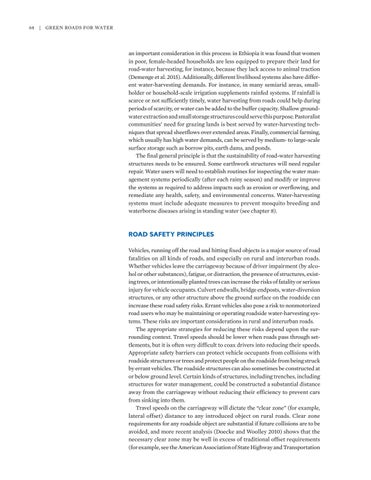64 | Green Roads for Water
an important consideration in this process: in Ethiopia it was found that women in poor, female-headed households are less equipped to prepare their land for road-water harvesting, for instance, because they lack access to animal traction (Demenge et al. 2015). Additionally, different livelihood systems also have different water-harvesting demands. For instance, in many semiarid areas, smallholder or household-scale irrigation supplements rainfed systems. If rainfall is scarce or not sufficiently timely, water harvesting from roads could help during periods of scarcity, or water can be added to the buffer capacity. Shallow groundwater extraction and small storage structures could serve this purpose. Pastoralist communities’ need for grazing lands is best served by water-harvesting techniques that spread sheetflows over extended areas. Finally, commercial farming, which usually has high water demands, can be served by medium- to large-scale surface storage such as borrow pits, earth dams, and ponds. The final general principle is that the sustainability of road-water harvesting structures needs to be ensured. Some earthwork structures will need regular repair. Water users will need to establish routines for inspecting the water management systems periodically (after each rainy season) and modify or improve the systems as required to address impacts such as erosion or overflowing, and remediate any health, safety, and environmental concerns. Water-harvesting systems must include adequate measures to prevent mosquito breeding and waterborne diseases arising in standing water (see chapter 8).
ROAD SAFETY PRINCIPLES Vehicles, running off the road and hitting fixed objects is a major source of road fatalities on all kinds of roads, and especially on rural and interurban roads. Whether vehicles leave the carriageway because of driver impairment (by alcohol or other substances), fatigue, or distraction, the presence of structures, existing trees, or intentionally planted trees can increase the risks of fatality or serious injury for vehicle occupants. Culvert endwalls, bridge endposts, water-diversion structures, or any other structure above the ground surface on the roadside can increase these road safety risks. Errant vehicles also pose a risk to nonmotorized road users who may be maintaining or operating roadside water-harvesting systems. These risks are important considerations in rural and interurban roads. The appropriate strategies for reducing these risks depend upon the surrounding context. Travel speeds should be lower when roads pass through settlements, but it is often very difficult to coax drivers into reducing their speeds. Appropriate safety barriers can protect vehicle occupants from collisions with roadside structures or trees and protect people on the roadside from being struck by errant vehicles. The roadside structures can also sometimes be constructed at or below ground level. Certain kinds of structures, including trenches, including structures for water management, could be constructed a substantial distance away from the carriageway without reducing their efficiency to prevent cars from sinking into them. Travel speeds on the carriageway will dictate the “clear zone” (for example, lateral offset) distance to any introduced object on rural roads. Clear zone requirements for any roadside object are substantial if future collisions are to be avoided, and more recent analysis (Doecke and Woolley 2010) shows that the necessary clear zone may be well in excess of traditional offset requirements (for example, see the American Association of State Highway and Transportation







































